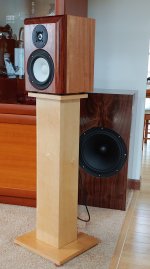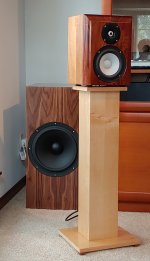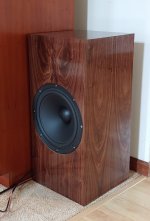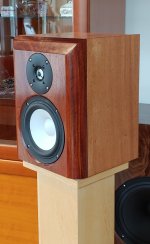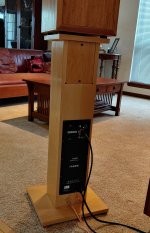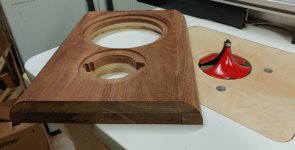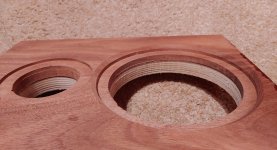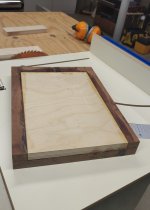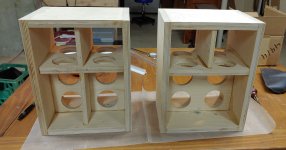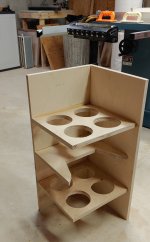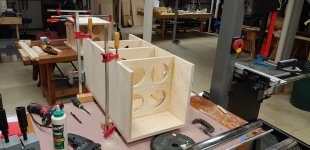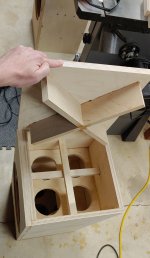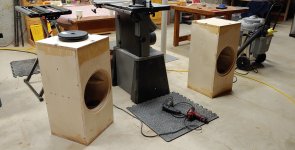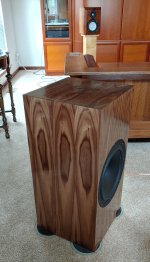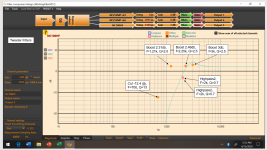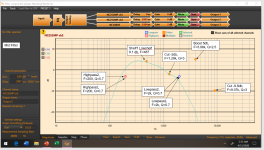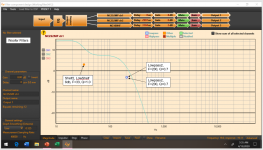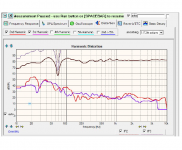I just completed a new active 3 way system. I used a pair of Hypex Fusion FA253 amps.
Woofers are SBA SB34NRX75-6, in a 70 liter sealed box. The ideal sealed box for this woofer is about 110 liters, so I used a Linkwitz transform to adjust the response. boost starts at 38 Hz, and by 26 Hz I have 6 db of boost. The crossover to the mid is currently 200 Hz LR4.
The mids are SBA SB17CAC35-4, an aluminum/ceramic 6 inch driver. The box is 10 liters sealed. The cabinets have 1.5 inch roundover on the sides, and a 30 / 60 degree dual bevel along the top.
The tweeters are SBA SB26CDC-C000-4, an aluminum/ceramic dome. Crossover from the mid is 2 kHz LR4.
The Hypex DSP features are powerful, and I was able to equalize all the drivers flat through the passband and stopband. I applied digital delay to the mid and tweeter to bring all the drivers into the same plane as the woofer. The Hypex amp is mounted in the speaker stand.
I am not done fine tuning the filters, but I am going to listen to them for a few weeks before I make any further adjustments. They sound pretty amazing right now.
Thanks for everyone who conversed with me over the last 7 months. I learned a lot, and this project would not have been successful without the DiyAudio community.
Woofers are SBA SB34NRX75-6, in a 70 liter sealed box. The ideal sealed box for this woofer is about 110 liters, so I used a Linkwitz transform to adjust the response. boost starts at 38 Hz, and by 26 Hz I have 6 db of boost. The crossover to the mid is currently 200 Hz LR4.
The mids are SBA SB17CAC35-4, an aluminum/ceramic 6 inch driver. The box is 10 liters sealed. The cabinets have 1.5 inch roundover on the sides, and a 30 / 60 degree dual bevel along the top.
The tweeters are SBA SB26CDC-C000-4, an aluminum/ceramic dome. Crossover from the mid is 2 kHz LR4.
The Hypex DSP features are powerful, and I was able to equalize all the drivers flat through the passband and stopband. I applied digital delay to the mid and tweeter to bring all the drivers into the same plane as the woofer. The Hypex amp is mounted in the speaker stand.
I am not done fine tuning the filters, but I am going to listen to them for a few weeks before I make any further adjustments. They sound pretty amazing right now.
Thanks for everyone who conversed with me over the last 7 months. I learned a lot, and this project would not have been successful without the DiyAudio community.
Attachments
Some construction pics:
The satellites are 3/4 inch baltic birch plywood, with the baffle being a composite of 3/4 solid african mohogany and 3/4 BB plywood.
In the 4th photo you can see the bracing scheme for the satellites. On the left box you are looking at the rear, on the right box you are looking at the front. The rear baffle is inset, and the front baffle overlays the box.
The next photo shows the primary bracing for the woofer boxes. Upper and lower bulkheads (some call them holey braces) and a central solid bulkhead shaped around the woofer magnet.
The woofer boxes are 3/4 inch baltic birch ply, front baffle is a double layer.
The 7th photo shows the secondary bracing for the tops and bottoms.
The satellites are 3/4 inch baltic birch plywood, with the baffle being a composite of 3/4 solid african mohogany and 3/4 BB plywood.
In the 4th photo you can see the bracing scheme for the satellites. On the left box you are looking at the rear, on the right box you are looking at the front. The rear baffle is inset, and the front baffle overlays the box.
The next photo shows the primary bracing for the woofer boxes. Upper and lower bulkheads (some call them holey braces) and a central solid bulkhead shaped around the woofer magnet.
The woofer boxes are 3/4 inch baltic birch ply, front baffle is a double layer.
The 7th photo shows the secondary bracing for the tops and bottoms.
Attachments
This pic shows the end caps (top and bottom) being glued onto the woofer cabinet. Most of the adhesive I used was Titebond III (a PVA wood glue), but for the tops and bottoms I used West Systems epoxy. I have a lot of epoxy experience because I have refurbished an old boat. Epoxy mixed with colloidal silica and microfibers has excellent gap-filling properties, and I had some gaps in the top and bottom fit-up.
I also used epoxy to laminate the satellite baffle together. The solid mahogany and the birch plywood were epoxied together, and then later epoxy was used to attach the front baffle to the box carcass.
Also in the pic you can see some dark wood plugs where I used screws. I had a spare walnut dowel from another furniture project, and there are other birch and maple plugs which you can not see very well. Although I was able to get a close fit between the bracing and the cabinet walls (close enough for normal furniture and cabinet making), I knew that speaker cabinet stiffness would depend on an exact fit. In some cases I used shims to fill any small gaps, but most of the time the fit was close enough I could just use counterbored screws to pull the cabinet walls tight against the bracing.
The satellites are veneered with Brazilian mahogany, and the front baffle is African mahogany. Before varnish, they were closer in color to each other, but after varnish it is more like a two-toned finish. The woofer cabinets are walnut veneer. The speaker stands are veneered in maple.
This was my first time working with veneer. All my previous furniture projects have been in solid wood. I used PSA (Pressure Sensitive Adhesive) backed veneer, also known as peel-and-stick. Before applying the veneer, I used a belt sander to make all the butt edges smooth and flush with the panels. The veneer vendor advised me to put down a coat of finish on the raw plywood before veneering, he said that PSA sometimes did not adhere well to raw wood. He advised a coat of water based polyurethane. However, I did some experimenting, and found that as long as the plywood was smooth and dust free, the PSA adhered very well. After belt sanding the cabinets, I used a cabinet scraper to leave a smooth burnished surface, then I vacuumed the surface.
I also used epoxy to laminate the satellite baffle together. The solid mahogany and the birch plywood were epoxied together, and then later epoxy was used to attach the front baffle to the box carcass.
Also in the pic you can see some dark wood plugs where I used screws. I had a spare walnut dowel from another furniture project, and there are other birch and maple plugs which you can not see very well. Although I was able to get a close fit between the bracing and the cabinet walls (close enough for normal furniture and cabinet making), I knew that speaker cabinet stiffness would depend on an exact fit. In some cases I used shims to fill any small gaps, but most of the time the fit was close enough I could just use counterbored screws to pull the cabinet walls tight against the bracing.
The satellites are veneered with Brazilian mahogany, and the front baffle is African mahogany. Before varnish, they were closer in color to each other, but after varnish it is more like a two-toned finish. The woofer cabinets are walnut veneer. The speaker stands are veneered in maple.
This was my first time working with veneer. All my previous furniture projects have been in solid wood. I used PSA (Pressure Sensitive Adhesive) backed veneer, also known as peel-and-stick. Before applying the veneer, I used a belt sander to make all the butt edges smooth and flush with the panels. The veneer vendor advised me to put down a coat of finish on the raw plywood before veneering, he said that PSA sometimes did not adhere well to raw wood. He advised a coat of water based polyurethane. However, I did some experimenting, and found that as long as the plywood was smooth and dust free, the PSA adhered very well. After belt sanding the cabinets, I used a cabinet scraper to leave a smooth burnished surface, then I vacuumed the surface.
Attachments
Last edited:
yeah, especially sub boxes looks good
Thanks... my wife was very pleased with how it turned out. Here is the other sub
I applied 3 coats of General Finishes Arm-R-Seal (gloss) using a 2 inch wide china bristle brush. After the first coat I sanded with 220, and after the second coat I sanded with 320.
Attachments
I recall you posted on my Cathedrals thread. I'd be interested if you could post your transfer functions if you have these available please.
Dave - do you mean the filter and EQ settings I used in the HFD software? I am not sure how to export them and display them... I could take screen shot of the HFD filter design window, but that does not give you all the filter information for each filter. Maybe I am missing something?
jim
Here is the tweeter response. First is the fully eq'd response without the crossover filter, and the second is the response with the filter.
Notice the ripple above 5k? I now think that is a reflection/diffraction from my hacked up microphone stand. I had the mic several inches from a hard reflecting surface. I had thought a small 5 inch by 6 inch plywood shelf would not affect the response... well I think I was wrong.
Notice the ripple above 5k? I now think that is a reflection/diffraction from my hacked up microphone stand. I had the mic several inches from a hard reflecting surface. I had thought a small 5 inch by 6 inch plywood shelf would not affect the response... well I think I was wrong.
Attachments
Here is the mid response. First is the fully eq'd response, then the response with the crossover.
Crossover is 4th order LR at 200 Hz and 2 kHz.
Jim
is there a way to embed these plots as images so people don't have to continuously download the pdf? Or do I need to convert them to jpg or png on my end ?
Crossover is 4th order LR at 200 Hz and 2 kHz.
Jim
is there a way to embed these plots as images so people don't have to continuously download the pdf? Or do I need to convert them to jpg or png on my end ?
Attachments
Last edited:
Here is the full response of the satellite, first in 1/48th octave and then in 1/6 octave smoothed.
As I mentioned, I am not done with the filtering, but I want to listen to it for a few weeks before I make any changes.
As I mentioned, I am not done with the filtering, but I want to listen to it for a few weeks before I make any changes.
Attachments
I recall you posted on my Cathedrals thread. I'd be interested if you could post your transfer functions if you have these available please.
Dave - perhaps you may find this useful. I recall that you are using SB aluminum mid and tweeter drivers which are very similar to mine. These are screen shots of the Hypex HFD designer window. I added text boxes to describe each filter element.
On the tweeter, I used a notch filter at the 700 Hz resonance frequency, plus some eq to tailor the response between 1k and 4k. To achieve a 4th order LR crossover, you use two identical biquads (2nd order high pass or low pass with Q=0.7).
On the mid there is a lot going on. At 200 Hz I have the cascaded highpass crossover filters, then at 487 Hz I have the baffle step correction. There is some EQ at 1.29 kHz. Then the cascaded Lowpass crossover filters at 2 kHz. In the stop band I have some EQ at 3.96 kHz, and at 9 kHz.
On the woofers I have a 2nd order shelf at 33 Hz with a Q of 1.0. This EQs my bass response to be flat down to ~ 27 Hz. It basically transforms my 70 liter box into a 110 liter box by using extra electrical power. Then I have the 200 Hz crossover, again using cascaded 2nd order filters.
I want to emphasize again that this is not the final filter, and I am already thinking of ways to do it better. However, it sounds pretty good right now.
I have designed pasive crossovers in the past, and I have used Xsim quite a bit, but this HFD process was new to me. I spent at least 2 hours on each driver getting the EQ flat for an octave above/below the crossover. Then I added the crossovers and spent another day tweeking the EQ to get it flat and nice. So it is not an instantaneous process, but it is much faster than assembling passive crossover components.
Jim
Attachments
Last edited:
Thanks for sharing!!!
Great looking set!!! Nice finishing too.
I have been eyeballing that same tweeter for my first DIY pair. The amount of things you have going on in the XO has me a bit worried for my first attempt.
Between the boost on the bass and your listening levels, was the FA253 overkill or worth it vs the FA123? Where is your volume?
I am looking to make an eerily similar setup.
Great looking set!!! Nice finishing too.
I have been eyeballing that same tweeter for my first DIY pair. The amount of things you have going on in the XO has me a bit worried for my first attempt.
Between the boost on the bass and your listening levels, was the FA253 overkill or worth it vs the FA123? Where is your volume?
I am looking to make an eerily similar setup.
SB26CDC Tweeter: I really like this driver. The response is very smooth and easy to work with. In my measurements in post 10 and 11 I had a reflection from my hacked-up microphone stand which caused a ripple between 2kHz and 10kHz. Once I got a proper mic boom and wrapped it in foam, the response is much smoother. It sounds really good, open and airy, no harshness, very non-fatiguing.
Don’t worry about the seemingly complex eq on the tweeter. The Hypex-recommended filter design approach is to eq the drivers to be flat for at least 1 octave beyond the crossover point. The tweeter did not need any eq within its operating range (pass band), but it had a shallow roll-off below 3k when mounted in my cabinet. I probably could have used a single shelf filter, but using 3 small boosts worked well. From what I have read, a loudspeaker driver is a minimum phase device, so any combination of DSP biquad filters which result in a flat response is the same as any other combination of biquads. Either way the result is a flat frequency response and a minimal phase shift.
I attached a plot of the harmonic distortion for my system. You can see that the 2nd and 3rd harmonic distortion is running about -55 dB from 100 Hz on up… that is 0.2%, which is quite good performance (although the signal level was pretty low at just 85 dB SPL). This shows the excellent performance of both the mid and the tweeter.
FA123 vs FA253: The FA253 is double the power, which in the real world is just an extra 3 dB. I knew I was going to be boosting the bass response below 40 hz with the Linkwitz transform, and I also knew that the small satellite baffle would need about 6 dB of boost to overcome the baffle step. I also knew that my total cost for the project was going to be about $2500, so the cost difference between a pair of FA123s and a pair of FA253s seemed small in the overall scheme.
I have never come close to using the full power capabilities of these amps. I usually listen at about 90 dB.
Don’t worry about the seemingly complex eq on the tweeter. The Hypex-recommended filter design approach is to eq the drivers to be flat for at least 1 octave beyond the crossover point. The tweeter did not need any eq within its operating range (pass band), but it had a shallow roll-off below 3k when mounted in my cabinet. I probably could have used a single shelf filter, but using 3 small boosts worked well. From what I have read, a loudspeaker driver is a minimum phase device, so any combination of DSP biquad filters which result in a flat response is the same as any other combination of biquads. Either way the result is a flat frequency response and a minimal phase shift.
I attached a plot of the harmonic distortion for my system. You can see that the 2nd and 3rd harmonic distortion is running about -55 dB from 100 Hz on up… that is 0.2%, which is quite good performance (although the signal level was pretty low at just 85 dB SPL). This shows the excellent performance of both the mid and the tweeter.
FA123 vs FA253: The FA253 is double the power, which in the real world is just an extra 3 dB. I knew I was going to be boosting the bass response below 40 hz with the Linkwitz transform, and I also knew that the small satellite baffle would need about 6 dB of boost to overcome the baffle step. I also knew that my total cost for the project was going to be about $2500, so the cost difference between a pair of FA123s and a pair of FA253s seemed small in the overall scheme.
I have never come close to using the full power capabilities of these amps. I usually listen at about 90 dB.
Attachments
I found the SBA published frequency response curves to be accurate. From 200 to 2k, there was virtually no difference between on-axis and 30 degrees off axis. At 60 degrees off axis, the response dropped by a few dB between 1k and 2k.
The off-axis response was so smooth and even, I did all my filter design work with the on-axis measured data.
The off-axis response was so smooth and even, I did all my filter design work with the on-axis measured data.
- Home
- Loudspeakers
- Multi-Way
- New active 3-Way, Hypex and SB
